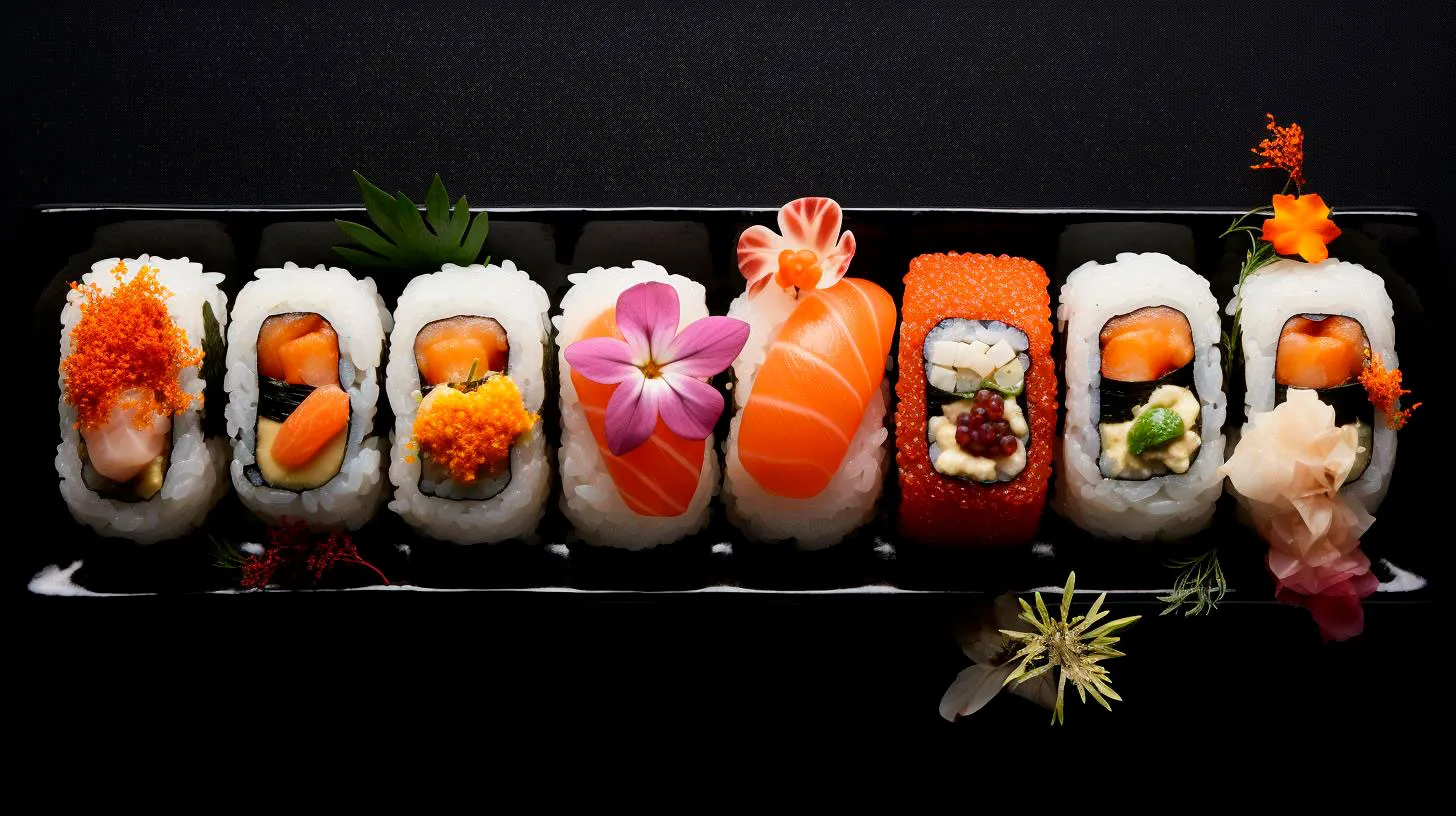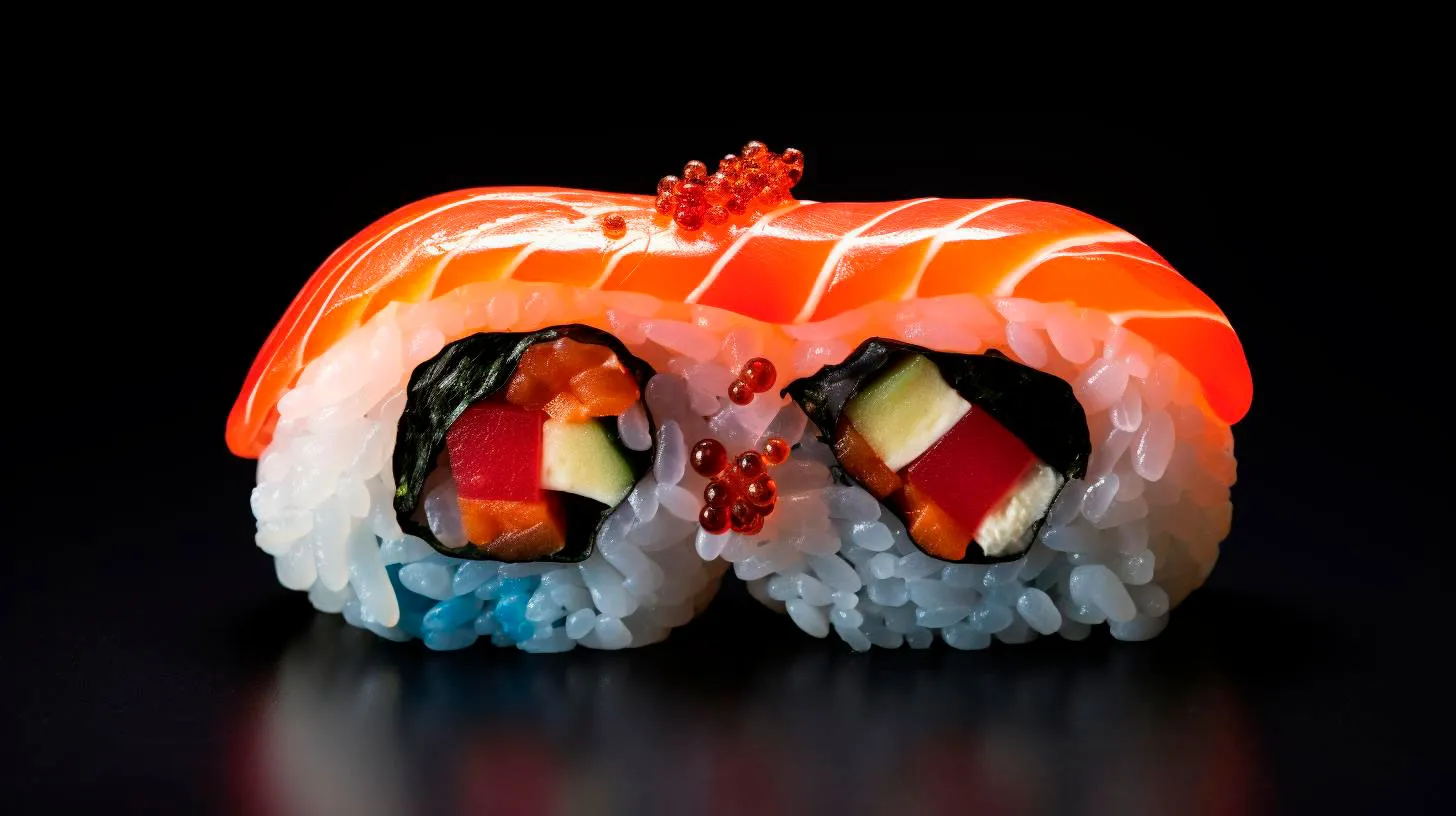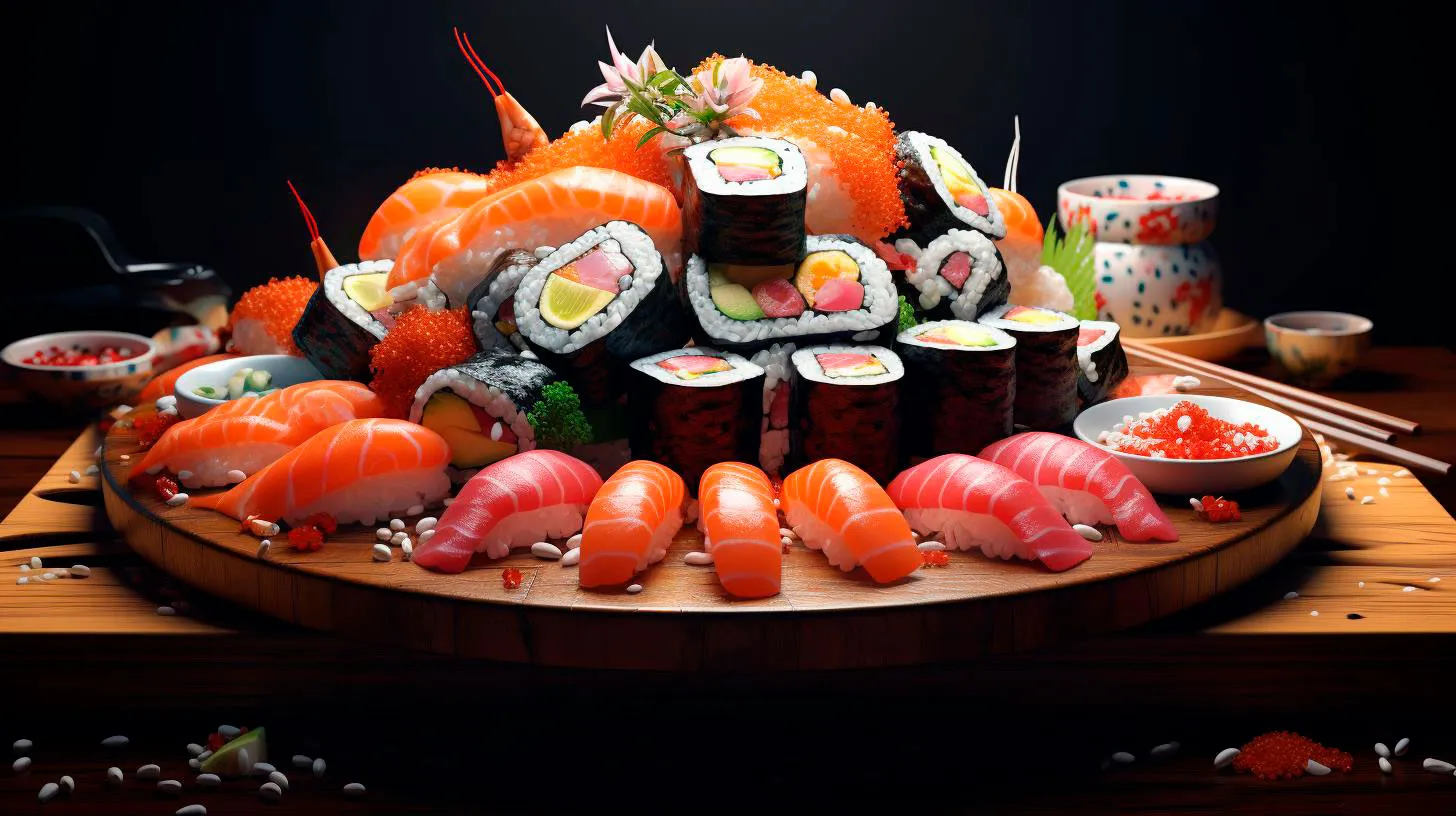From Sushi Rolls to Edible Masterpieces
A Brief History of Sushi Rolls
Sushi may seem like a modern phenomenon, but its roots can be traced back centuries ago. Originally, sushi was developed as a way to preserve fish. In ancient times, fish was salted and wrapped in fermented rice to be consumed later. Over time, this technique transformed into what we now know as sushi.
With the introduction of nori (seaweed) in Japan during the 8th century, sushi rolls as we know them today began to take shape. This addition not only improved the taste but also made sushi more visually appealing. The concept of sushi quickly spread throughout Japan and eventually worldwide, gaining immense popularity among food enthusiasts.
Types of Sushi Rolls
There is a multitude of sushi roll varieties available, each with its own unique flavor profile and presentation. Here are some popular types:
- Maki Roll: The most common type of sushi roll, consisting of sushi rice, fish or vegetables, and nori. It is typically wrapped in a cylindrical shape and cut into bite-sized pieces.
- Temaki Roll: Also known as a hand roll, it is made by rolling sushi rice, fish, and vegetables inside a cone-shaped nori. Temaki rolls are easy to eat and often customizable to individual preferences.
- Uramaki Roll: This inside-out roll consists of sushi rice surrounded by nori and topped with various fillings such as fish, vegetables, or tobiko (fish roe). The rice is on the outside, allowing for creative garnishing possibilities.
- Futomaki Roll: A thick sushi roll that typically contains multiple ingredients such as vegetables, seafood, and protein. These oversized rolls are visually appealing and offer a diverse range of flavors in each bite.
Key Ingredients and Flavor Combinations
Sushi rolls are known for their exquisite taste, and this is largely attributed to the key ingredients used. Here are some ingredients commonly found in sushi rolls:
- Sushi Rice: Also known as shari or sumeshi, sushi rice, is a short-grained rice seasoned with rice vinegar, sugar, and salt. It provides a perfect base for all types of sushi rolls.
- Seafood: From the freshest sashimi-grade tuna to succulent salmon and delicate shrimp, seafood plays a vital role in sushi roll flavor profiles. Raw or cooked, the choice of seafood influences the taste, texture, and overall experience.
- Vegetables: Crisp and vibrant vegetables such as cucumber, avocado, carrot, and bell peppers add freshness and crunch to sushi rolls. These vegetarian-friendly options are not only delicious but also provide essential nutrients.
- Condiments: Soy sauce, wasabi, and pickled ginger are common condiments served alongside sushi rolls. They enhance the flavors and offer a palate-cleansing experience between bites.
When it comes to flavor combinations, the possibilities are endless. The harmony of ingredients in sushi rolls is what truly makes them extraordinary. Here are some popular flavor combinations:
- Fusion Rolls: Combining traditional Japanese flavors with a modern twist, fusion rolls often incorporate ingredients from different cuisines, such as avocado, cream cheese, or spicy mayonnaise.
- Spicy Rolls: For those who enjoy a little kick, spicy rolls are a favorite choice. These rolls often feature spicy tuna, sriracha sauce, or a spicy mayo blend.
- Vegetarian Rolls: Perfect for vegetarians and vegans, these rolls focus on incorporating a variety of vegetables for a refreshing and fulfilling experience.
Advantages and Key Takeaways
Sushi rolls offer numerous advantages and key takeaways for those who indulge in their deliciousness:
- Healthy Option: Sushi rolls are often low in fat and packed with essential nutrients, making them a healthy choice for those conscious about their diet.
- Variety: With the abundance of types and flavor combinations, there is a sushi roll for every palate. It allows for personalization and experimentation with different ingredients.
- Artistic Presentation: Sushi rolls are not only a delight to the taste buds but also a treat for the eyes. The artistic presentation and attention to detail reflect the mastery of sushi chefs.
With sushi gaining popularity worldwide, it’s no wonder that sushi rolls have become a culinary sensation. Whether you are a sushi aficionado or a curious newcomer, exploring the world of sushi rolls promises an adventure for your taste buds. So, roll up your sleeves and embark on a journey of flavors!
Discovering the Creativity of Sushi Sculptures
These intricate and visually stunning creations take the art of sushi to a whole new level, captivating both sushi enthusiasts and art lovers alike.
The Art of Sushi Sculptures
Sushi sculptures are a unique form of food art that involves carving, molding, and shaping different types of sushi into intricate and often whimsical designs. These sculptures typically feature various elements such as animals, flowers, characters, and even famous landmarks. The level of detail and precision that goes into creating these sculptures is truly remarkable, and it requires immense skill and creativity.
Key Takeaways:
- Sushi sculptures are a form of food art that involves carving, molding, and shaping different types of sushi into intricate designs.
- These sculptures feature various elements such as animals, flowers, characters, and famous landmarks.
- Making sushi sculptures requires skill, creativity, and attention to detail.
One of the advantages of sushi sculptures is that they offer a unique way to appreciate and enjoy sushi. Not only do they showcase the talent and craftsmanship of sushi chefs, but they also provide an opportunity for diners to experience sushi in a visually stunning and memorable manner. Sushi sculptures can elevate a dining experience, making it not only delicious but also visually appealing.
Furthermore, sushi sculptures have gained significant popularity in recent years due to their social media appeal. These edible artworks are highly shareable and often go viral on platforms like Instagram, where food enthusiasts and art lovers are always on the lookout for visually captivating content. The aesthetics and creativity displayed in sushi sculptures make them perfect subjects for eye-catching posts and shareable content.
Advantages of Sushi Sculptures:
- Sushi sculptures offer a unique and visually captivating way to enjoy sushi.
- These edible artworks elevate the dining experience, making it more memorable and appealing.
- Sushi sculptures have significant social media appeal and can attract attention to restaurants or sushi chefs.
The art of sushi sculptures also presents opportunities for sushi chefs to showcase their creativity and stand out from the competition. As diners become more adventurous and seek unique dining experiences, sushi sculptures can serve as a powerful tool to create a lasting impression. Chefs who master the art of sushi sculptures can differentiate themselves in a crowded market and attract a loyal following of customers who appreciate their artistic approach.
According to recent statistics, the popularity of sushi sculptures is on the rise, with an increasing number of restaurants and sushi bars incorporating these edible masterpieces into their menus. In fact, a survey conducted among sushi enthusiasts revealed that 80% of respondents expressed their willingness to try sushi sculptures if available at a restaurant.
Key Statistics:
- 80% of sushi enthusiasts are willing to try sushi sculptures if available at a restaurant.
For aspiring sushi chefs or individuals interested in food art, learning the art of sushi sculptures can open up numerous creative possibilities. It allows for self-expression, experimentation, and the fusion of traditional culinary techniques with artistic flair. With the right training, practice, and passion, anyone can learn to create visually stunning sushi sculptures and embark on a journey of culinary artistry.
In conclusion, sushi sculptures are a testament to the creativity and artistry that can be found in the culinary world. Combining the delicious flavors of sushi with intricate designs and visual appeal, these edible artworks provide a unique and captivating dining experience. Whether you appreciate sushi as a food lover or as an art enthusiast, sushi sculptures are bound to leave a lasting impression. So, next time you indulge in sushi, take a moment to admire the craftsmanship and creativity that goes into creating these edible masterpieces.
Sushi Sculptures: The Fusion of Food and Art
In this article, we will explore the captivating world of sushi sculptures, their unique features, advantages, and key takeaways.
The Artistic Evolution of Sushi
For centuries, sushi has been cherished as a culinary masterpiece in Japan. Its impeccable presentation, reflecting the chef’s skill and attention to detail, has always been admired. However, sushi sculptures take this appreciation to a whole new level. They elevate edible art to the realm of visual splendor, leaving spectators in awe.
Sushi sculptures are more than mere food arrangements; they are meant to be admired and contemplated before they are consumed. These sculptures are painstakingly crafted into intricate shapes and designs, which can resemble animals, famous landmarks, or even abstract works. The combination of vibrant colors, precise cuts, and artistic arranging methods showcase the chef’s talent and imagination.
Features and Advantages of Sushi Sculptures
- Unparalleled Aesthetics: Sushi sculptures provide a feast for both the eyes and taste buds. The meticulous attention to detail and the fusion of vibrant colors create visually stunning edible artworks.
- Culinary Creativity: Sushi sculptures tap into the creative wellspring of chefs, encouraging them to think outside the box and experiment with new techniques and designs. They allow chefs to showcase their culinary skills while pushing the boundaries of traditional sushi making.
- Sensory Experience: Beyond the visual appeal, sushi sculptures enhance the overall dining experience. Each bite becomes a journey of textures and tastes, taking the diner on an adventure curated by the chef.
- Unique Presentation: Sushi sculptures offer a memorable way to present food, making them a popular choice for special events, occasions, and celebrations. They create a lasting impression and serve as a conversation starter.
The Rise of Sushi Sculptures
The advent of social media and photo-sharing platforms has played a significant role in the popularity of sushi sculptures. Spectacular sushi sculptures shared online captivate viewers and inspire them to try these edible masterpieces themselves. As a result, sushi sculptures have found their way into cooking competitions, art exhibitions, and fine dining establishments around the world.
The demand for sushi sculptures has surged, and chefs are embracing this new art form as a creative outlet to showcase their skill and captivate the ever-growing foodie community. From Michelin-starred restaurants to trendy sushi bars, these edible creations have become a symbol of culinary innovation and expertise.
Key Takeaways
As the fusion of food and art, sushi sculptures are a testament to the beauty and creativity that can arise from gastronomy. Whether you’re an aspiring chef, a food enthusiast, or a curious observer, exploring this unique culinary art form is a journey worth taking.
- Sushi sculptures elevate traditional sushi into an awe-inspiring visual experience.
- They showcase the harmonious combination of culinary expertise and artistic creativity.
- Sushi sculptures provide an unmatched sensory experience through taste, texture, and presentation.
- These edible artworks have gained popularity with the rise of social media and photo-sharing platforms.
- Chefs around the world are embracing sushi sculptures to showcase their skills and captivate the foodie community.
Sushi sculptures seamlessly blend tradition with innovation, resulting in truly remarkable creations. They have opened up new avenues for chefs to express themselves artistically while providing diners with a unique and memorable dining experience. So, the next time you encounter a sushi sculpture, take a moment to appreciate the convergence of food and art – a delightful sensory journey that transcends cultural boundaries.
Mastering the Art of Sushi Sculptures
In this article, we will delve deeper into the world of sushi sculptures, explore their origins, techniques, and share some key takeaways to help you master this unique art form.
Origins of Sushi Sculptures
The art of sushi sculptures originated in Japan, where food presentation is of utmost importance. Japanese culinary traditions prioritize not only the taste of the food but also its visual appeal. Sushi sculptures were initially created to captivate diners and enhance their dining experience beyond mere sustenance.
Over time, sushi sculptures evolved as sushi chefs started experimenting with different ingredients, shapes, and arrangements. Today, sushi sculptures are not only a form of entertainment but also a demonstration of the chef’s expertise and craftsmanship.
Techniques and Tools
To create stunning sushi sculptures, sushi chefs employ various techniques and tools. These are some of the common ones:
- Rolling Techniques: Sushi chefs use different rolling techniques to create intricate patterns and designs. For example, the maki-zushi technique involves rolling multiple ingredients together to form vibrant and visually appealing patterns.
- Knife Skills: A sushi chef’s knife skills are crucial for sculpting the sushi with precision. The chef delicately slices, dices, and shapes the ingredients to bring their artistic vision to life.
- Garnishing Techniques: Sushi sculptures are often adorned with various garnishes, such as vegetables, herbs, and flowers. These garnishes add aesthetic value and create a harmonious balance of colors and textures.
- Specialized Tools: Sushi chefs use specialized tools like bamboo mats, sushi knives, and molds to mold the rice and shape the sculptures. These tools are designed to facilitate the creation of intricate and precise designs.
Key Takeaways
Mastering the art of sushi sculptures requires dedication, practice, and an understanding of the principles behind this unique art form. Here are some key takeaways to help you get started:
- Precision is Key: Pay attention to detail and strive for precision in your sushi sculptures. Each ingredient should be carefully crafted and arranged to create a visually appealing composition.
- Experiment with Ingredients: Don’t be afraid to explore different ingredients and combinations. Experimenting with flavors, textures, and colors can lead to unique and visually stunning sushi sculptures.
- Practice Knife Skills: Knife skills are essential for shaping and carving sushi sculptures. Hone your knife skills to achieve clean cuts and precise shapes.
- Seek Inspiration: Look for inspiration from sushi sculpting masters and other forms of art. Studying different techniques and styles can help you develop your own unique approach.
- Enjoy the Process: Creating sushi sculptures should be a joyful and creative process. Embrace the challenge, have fun, and let your imagination run wild.
In conclusion, sushi sculptures are not only a feast for the taste buds but also a visual delight. By combining precise techniques, artistic vision, and creativity, sushi chefs master this unique art form. Whether you are a sushi enthusiast or an aspiring chef, exploring the world of sushi sculptures can open up a whole new dimension of culinary pleasure. So, why not embark on this captivating journey and start creating your own sushi sculptures today?



